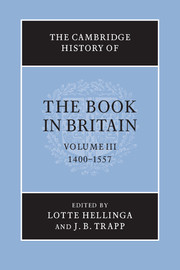Book contents
- Frontmatter
- Introduction
- 1 Literacy, books and readers
- TECHNIQUE AND TRADE
- COLLECTIONS AND OWNERSHIP
- READING AND USE OF BOOKS
- I BOOKS FOR SCHOLARS
- II PROFESSIONS
- III THE LAY READER
- 22 Schools and school-books
- 23 Practical books for the gentleman
- 24 Devotional literature
- 25 Gentlewomen’s reading
- 26 Music
- 27 Literary texts
- 28 Press, politics and religion
- Appendix
- List of abbreviations
- Bibliography
- Photo credits
- General index
- Index of manuscripts
- Bibliographic index of printed books
- Plate Section"
- References
26 - Music
from III - THE LAY READER
Published online by Cambridge University Press: 28 March 2008
- Frontmatter
- Introduction
- 1 Literacy, books and readers
- TECHNIQUE AND TRADE
- COLLECTIONS AND OWNERSHIP
- READING AND USE OF BOOKS
- I BOOKS FOR SCHOLARS
- II PROFESSIONS
- III THE LAY READER
- 22 Schools and school-books
- 23 Practical books for the gentleman
- 24 Devotional literature
- 25 Gentlewomen’s reading
- 26 Music
- 27 Literary texts
- 28 Press, politics and religion
- Appendix
- List of abbreviations
- Bibliography
- Photo credits
- General index
- Index of manuscripts
- Bibliographic index of printed books
- Plate Section"
- References
Summary
Music is first and foremost a performance art, and it relies only selectively upon written record for its propagation, practice and preservation. For that reason, music books (and the various forms of ephemera that existed alongside them) shed light on only a limited number of the musical activities that existed in late medieval Britain. To take an extreme case, very few notated sources of British instrumental music survive from before the sixteenth century. Almost certainly few ever existed, at least in permanent form. From pictorial and documentary evidence we know that musical instruments were played and appreciated at all levels of late medieval British society, from the most powerful and privileged down to the humblest. In almost all cases, however, the playing was done from memory and by ear. Professional instrumentalists – the trumpeters who performed on ceremonial occasions, the wind-players who accompanied meals or provided music for dance, the minstrels who entertained royalty and nobility, the waits who played at civic events – all appear to have learnt their repertoires largely by rote rather than from the book. It is unlikely that many of them relied upon musical notation; there was no reason why they should do so. Only with the rise of amateur music-making during the second half of the sixteenth century did notated instrumental music become at all common.
- Type
- Chapter
- Information
- The Cambridge History of the Book in Britain , pp. 541 - 554Publisher: Cambridge University PressPrint publication year: 1999

